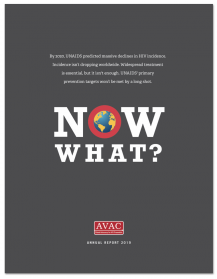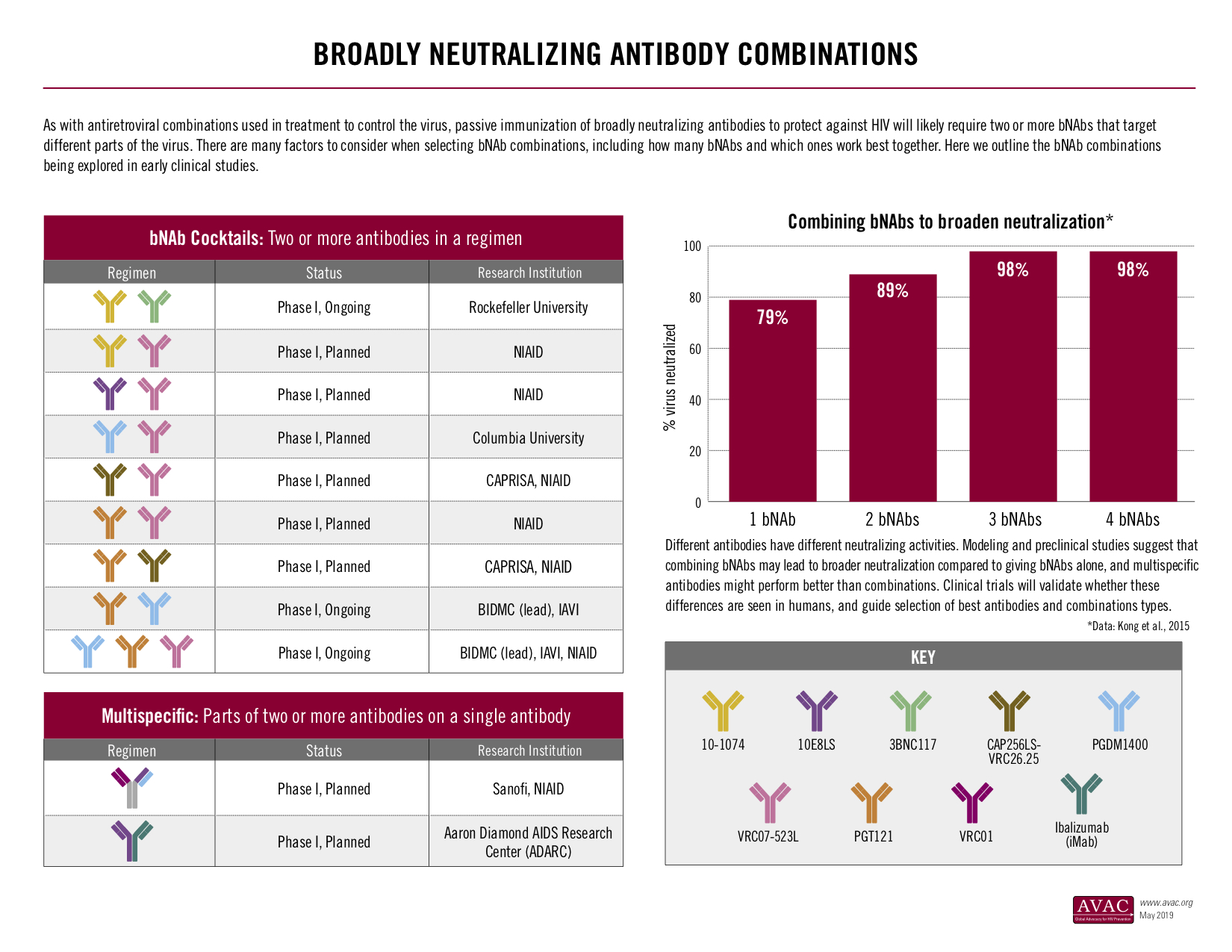This infographic shows a timeline for each of the three major vaccine efficacy trials proposed or underway now.
Vaccine Efficacy Trials Pipeline
Vaccines Research Pipeline
This graphic shows the many types of Vaccines undergoing research, categorized by the immune response they are designed to elicit—broadly neutralizing antibodies, non-neutralizing antibodies, T-cell responses or a combination of these.
AVAC Report 2019: With 2020 targets sure to be missed, we ask Now What?
Today, AVAC released Now What?, our 2019 annual report on the state of the HIV prevention field. Each year, the AVAC Report frames the most pressing advocacy issues facing the HIV response. At the threshold of 2020, it’s clear that global goals for HIV prevention will miss the mark by a long shot.
Though important progress has been made, the crisis UNAIDS called out in 2016 persists today with new infections around 1.7 million annually, a far cry from the 2020 target of fewer than 500,000.
So, we asked ourselves, Now What?, and answered with cross-cutting analysis and an advocacy agenda to match.
- Visit the Now What? website
- Download AVAC Report 2019: Now What?
- Download infographics from the Report
FIRST, we call for leadership that is bold, visible and activist, from the new head of UNAIDS, to houses of parliament to civil society coalitions: take uncompromising stances, demand accountability, speak out for intersectional issues of race, gender, class and climate. This work needs to be funded, full-throttle and fearless.
SECOND, we call for the use of today’s most recent evidence to guide new prevention targets that will pave the way for epidemic control. Clear milestones for the prevention research pipeline must be set. Investments over the past decades have provided us with the prevention options we have today, and much-needed new strategies are under now investigation. The field needs targets for prevention research that people can understand and influence.
THIRD, we call for multilayered prevention approaches that are centered around the person, not the virus. Since last World AIDS Day, we’ve learned again, perhaps most strikingly from the ECHO trial, about the dynamic needs of women for HIV and pregnancy prevention. The complexity of translating results into policy, bring renewed urgency to the need for comprehensive HIV prevention and reproductive health approaches. Multilayered prevention incorporates multipurpose strategies (i.e., products that prevent both pregnancy and HIV) within programs designed to address structural barriers (i.e., policy reform, transforming community norms, facilitating educational empowerment).
2020 will be a pivotal year—join us in calling on leaders, from the grassroots to global capitals, to make 2020 a turning point, when siloes come down, crises are transformed by innovation, and prevention is center stage in the fight against HIV.
Happy reading, and we’d love to hear how you answer Now What?
AVAC’s “3D” View of the World: 2019 and beyond
This infographic lays out AVAC’s top-line recommendations from AVAC Report 2019: Now What? The recommendations fall into three categories: deliver — prevention programs whose impact is well-measured and -defined; demonstrate — next-generation engagement for next-generation trials; develop — new targets for the post-2020 world.
HVAD 2019: Vaccine science needs your support!
[UPDATE: Slides and recordings from both webinars are now available. Links are provided below.]
HIV Vaccine Awareness Day (HVAD) 2019, on May 18, comes with promising headlines about advances in potential vaccines for HIV and other diseases that imperil public health. But, 2019 has also seen outbreaks of a highly infectious, vaccine-preventable disease, the result of misinformation and fear being spread by anti-vaccine campaigners.
This HVAD, AVAC has an updated toolkit of resources for translating HIV vaccine research with a renewed sense of urgency, and two dedicated hashtags to rally the call on social media: #HIVvaccineAware and #HVAD2019. We hope you’ll join the conversation — with the updated HVAD 2019 toolkit and our upcoming webinars (below and online)!
Explore all of our updated HVAD resources:
- HIV Vaccines—Key Messages lays out advocacy priorities and important updates from the field for the year ahead.
- HIV Vaccines, An Introductory Factsheet provides basic information on concepts and trials in vaccine research.
- Vaccines 101 slide deck reviews basic concepts and the status of research and development.
- HIV Vaccine R&D in 2019 slide deck provides this year’s updates on the state of the science and clinical trials.
- A suite of infographics, including updates on the Vaccine Efficacy Trials Pipeline; HIV-Specific Neutralizing Antibodies: Targets and research status; HIV Vaccine Trial Participation in 2019 and others that provide a visual overview of the HIV vaccine research landscape.
One of AVAC’s HVAD Toolkit infographics showing bNAb combination research.
We also hope you will join two upcoming webinars:
- On May 16, Mary Marovich, the Director of the Vaccine Research Program at the Division of AIDS at the National Institute of Allergy and Infectious Diseases, and long-time HIV vaccine research advocate and community leader, Mark Hubbard, discussed the current landscape of vaccine research. Recording: YouTube / Audio / Introductory Slides / Mary Marovich’s Slides
- On Thursday May 23, 9am ET, Heidi Larson, Director of the Vaccine Confidence Project will discuss the implications of vaccine hesitancy and other issues along with Laura Lopez Gonzalez, deputy editor of South Africa’s Bhekisisa Health Journalism Centre.Recording: YouTube / Audio / Slides
Resources like these are essential for public understanding and support for vaccine research. Vaccines are not simple products. They require sustained investment to develop, they can be challenging to manufacture, and just as challenging to explain to potential users.
This HVAD, join us in thanking the ongoing dedication and ingenuity – of scientists, trial participants and community advocates – to find a vaccine against HIV, and let us renew our commitment to advance public understanding and support for vaccine research, development and delivery.
HIV-Specific Neutralizing Antibodies – Targets and research status
Numerous studies, both early and late phase, are investigating the efficacy of neutralizing antibodies. This infographic shows the ongoing studies and the differing locations they target on the virus.
One Timeline, Two Stories, One Message: Putting trials and targets together
One problem with HIV prevention agendas is that they either live in an eternal present or in a far-off future. It’s “work with what we’ve got, which is condoms and VMMC and a little bit of PrEP”, or it’s “nothing can change without an AIDS vaccine”. The future depends on using what’s available, better and more widely, without ever losing sight of what’s in the pipeline.
As the figures below show, in the very same timeframe that the world will miss its critical target for incidence reduction and scale-up of primary prevention, several trials will release results that could change the future. 2020 will be a time of hope and reckoning. But only if the two stories start to be told as one.
HIV Prevention Research and Demonstration Sites in South Africa
This map demonstrates the breadth of HIV prevention research and demonstration projects in South Africa by site and type (e.g. daily oral PrEP demo projects, ARV-based rings, long-acting injectable PrEP, preventative Vaccines, antibodies, hormonal contraceptives). This map was developed by Wits RHI with support from AVAC as part of the Coalition to Accelerate and Support Prevention Research. This graphic first appeared in AVAC Report 2017: Mixed messages and how to untangle them.
No Prevention, No End – AVAC launches new report and call to action
Today AVAC released No Prevention, No End, our 2018 annual report on the state of the field. Starting from the title—which humbly borrows the cadence of the call for an end to state-sanctioned violence against Black Americans, “No Justice, No Peace”—through to the closing words, “This is the worst possible moment for slowing down,” the Report is a call to action and guide for addressing the HIV prevention crisis that threatens progress in curtailing epidemics worldwide.
Click here to download the Report and individual sections and graphics; click here for a new episode of the Px Pulse podcast which covers the Report’s key themes and features lead author Emily Bass, AVAC’s Director of Strategy and Content.
UNAIDS named the prevention crisis in its July 2018 report, Miles to Go. It acknowledged that the scale-up of antiretroviral treatment, while essential, is insufficient as a prevention strategy. AVAC has been warning of an imbalance in approaches and investments across approaches, and calling for ambitious targets matched with political will, financing, timelines and more since the UNAIDS targets were first launched in 2014. (Check out AVAC Report 2014/5: Prevention on the Line for a summary of this critique of targets.)
In this year’s Report, we call out three core problems with primary prevention and the global HIV response, identifying the risks they bring and the path to a solution. Specifically, we focus on:
- Investing in demand creation: The private-sector gloss on this term cannot obscure its essential role in making primary prevention work. Strategies that might save lives are condemned as unwanted or unfeasible when they’re delivered in programs that lack integrated demand-side thinking, which is a science and not a set of slogans.
- Making informed choice central to HIV prevention: Programs that offer more than one option, along with a supportive environment for a provider and client to discuss risks, benefits and personal preferences aren’t a luxury but a necessity. The family planning field has metrics to measure choice; HIV should pick these up, with prevention programs leading the way.
- Unstinting radical action: Progress in the global AIDS response is tenuous; so is the state of democratic institutions and the future of the planet. These interconnected issues require more bold action, including from countries that are aid beneficiaries, and from the citizens of those countries who unite to hold truth to power. In the HIV prevention context, this means accountability for primary prevention at every level, including research for next-generation options.
AVAC is launching this Report as many stakeholders in HIV prevention research gather in Madrid for the HIV Research for Prevention (R4P) conference. Visit our special R4P page to find us on-site and follow along from afar, to see how the themes of this year’s Report resonate in a global and wide-ranging discussion of HIV prevention research and implementation at a critical time.
HIV Vaccine Awareness Day 2018: Tools & more
HIV Vaccine Awareness Day, May 18, commemorates the vital and ongoing work to develop a vaccine against HIV. This work advances because of the ingenuity, courage and commitment of trial participants, host communities, funders, scientists and advocates. AVAC salutes the collective trust and sustained dedication to end the epidemic.
2018 is marked by great advances in research and important opportunities for advocacy. In addition to a host of tools AVAC updates annually to keep you current on this front, The Rise of Broadly Neutralizing Antibodies by AVAC founder and former Global HIV Vaccine Enterprise executive director Bill Snow offers a comprehensive look at antibody mediated prevention and its connection to vaccine research.
In case you missed it, check out the recording and slides from the May 17 webinar featuring Dr. Sandhya Vasan’s discussion on the legacy of RV144 and vaccine advocate Mark Hubbard’s take on today’s agenda for HIV vaccine advocacy.
The complete set of AVAC’s HVAD resources includes:
- A special advocacy publication, The Story Is…, looking at three major efficacy trials in the context of funding, advocacy, stakeholder engagement and primary prevention
- A package of infographics on key issues
- HIV Vaccines: Introductory Fact Sheet
- A PowerPoint presentation: HIV Vaccine Basics
- A selection of key messages related to HIV vaccine advocacy
And add to the conversation on social media at #HIVvaccineAware and #HVAD2018.

